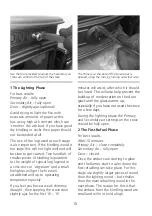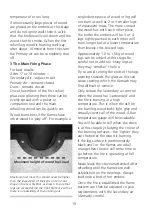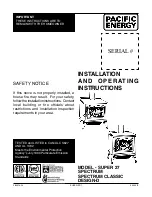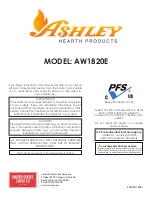
16
IMPORTANT: FIRST FIRES
Use smaller and shorter ‘gentle’ fires
the first five or six times that you fire up
the stove, making these progressively
bigger, as this will avoid any potential
thermal shock and allow the cast iron
components to ‘acclimatise’ with each
other. Allow the stove to fully cool
down between these fires.
When first using the stove it is normal
to experience paint fumes or see light
smoke rising from some of the stove’s
painted surfaces. During this stage
ensure that the room has additional
ventilation by opening doors and
windows to minimise any adverse
effects.
The hotter you burn the stove the more
intense these fumes will be, which is
one of the reasons that we advise that
you use smaller fires to start with. Every
time the stove reaches a new higher
temperature it may still be possible to
smell these fumes or see some
gentle smoke until the paint work is
fully cured.
If smoke and fumes persist do not use
the stove and immediately consult your
installer, as this may indicate that there
could be a possible problem with the
installation.
BURNING WOOD LOGS
Your new stove can burn very well, or
very poorly, depending on how you
light the fire, how you refuel the fire,
and, of course, the type and quality of
the fuel that you are burning. A flue
temperature gauge and log moisture
meter are both cost-effective invest-
ments and are highly recommended if
you want to maximise the efficiency of
your stove and fuel.
Wear protective gloves when loading a
burning stove and place logs precisely
where you want them by using heat-
resistant tongs if necessary.
Always open the stove door gently to
avoid unnecessary air turbulence due to
the differences in air pressure between
the stove and the room which could
cause ash or small lighted embers to
be drawn from the fire chamber and
beyond the protective hearth. Never
operate the stove without the fire fence
(or log guard) in position.
The stove is not designed to be
operated with the door open.
The Wood Fire
Wood takes its combustion air from the
top of the fire chamber so understand-
ing how and you use the Secondary air
control (which also controls the airwash)
at the top of the stove is important.
Wood will always burn best on a bed of
its own embers which also forms a
barrier that helps reflects the heat and
protects the fire grate from being
damaged. Therefore you should leave a
bed of ash in place to create a layer of
approximately 25mm (1”), only
Summary of Contents for HF217-SE Baby Gabriel
Page 2: ......
Page 7: ...7 GENERAL DIMENSIONS 414 435 555 95 134 345 134 125 ø All dimensions are in mm ...
Page 43: ......
















































